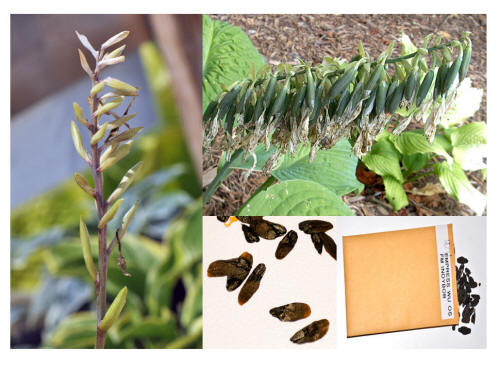|
 |
|
|
|

|
|
 |
Hostas are seed bearing plants.
Seeds, of course, are generally the result of pollen from one
plant being transported to the pistil of another plant (except
in those plants that readily self-pollinate). This results in
seeds and seedlings which are a combination of the genetic
material of the two plants.
The three chambers of the ovaries will
develop into a three chambered seed pod. Each section will have two
rows of flat, single winged seeds. Hosta species and cultivars vary
widely in their ability to set seed. Some cultivars will be covered
with seed pods while others will rarely, if ever set any seed.
Certain hosta hybrid cultivars are sterile and, therefore, will
never set seeds at all.

Hostas fall into one of two basic
categories in terms of their ability to produce seeds...either
they do or they don't. If they do produce seeds, they can be
self-pollinated or open-pollinated. In addition, those seeds may
be viable or non-viable (in some cases the viability is
unknown). See below for more detail on each type.
|
|
 |
Most hostas
will produce seeds capable of germinating and growing a new
plant. Of course, hybridizers take advantage of this fact to
manually take the pollen (male flower) from one plant and
move it to the pistil (female flower) of another plant. Of
course, just because a hosta bears seeds does not
automatically mean that they are viable i.e. able to
germinate.
|
|
 |
Hostas designated this way in our
lists are plants where hybridizers have applied the pollen to
the pistil of the same plant by hand. They kept records of their
actions so that they know that the resulting seeds have only the
genetic material of a single plant.
|
|
 |
In nature and in the cultivated
hosta garden, bees do most of the pollinating. They move
randomly from plant to plant so that the pollen parent (father)
can not be known by the gardener. Hybrid plants that do not have
a pollen parent identified are considered to be open-pollinated
so half of its genetic background is unknown.
|
|
 |
Some hostas, especially those hybrids that resulted from
a cross pollination (i.e. not sports) are sometimes sterile. They
will produce flowers but will not produce seeds at the end
of the season. The scapes of these plants, therefore, will
not bear seed pods.
|
|
 |
Hostas listed in this category
are those for which someone has successfully germinated seeds to
produce new plants.
|
|
 |
On many hosta registration forms,
the comment is made that the new cultivar sets seeds but its
viability is unknown. All this means is that nobody has
documented the successful germination of them.
|
|
 |
Occasionally, the plant will produce seeds but they do not
have the ability to germinate and produce a seedling.
|
|
 |
Hosta seeds
are ready to plant once they are ripe in the seed pod. Some
perennials need to have their seeds treated by either
scarification or stratification but hosta seeds need neither.
Instead, if you want to get them off to a fast start, you can
plant them under fluorescent lights in your basement and watch
them grow through the winter. If you need to wait to plant them,
dry seeds may be kept in a freezer until needed.
|
 |
|
|



